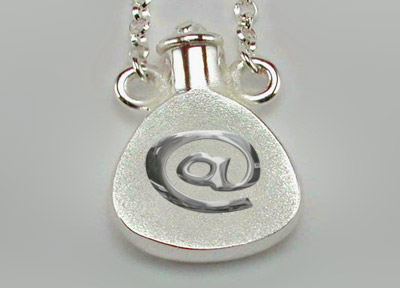
The now ubiquitous a with a circle curling around it is generally referred to as the 'at' symbol. There is, however, no universal name for this sign.
Several languages use words that associate the shape of the symbol with animals:
apenstaartje - Dutch for 'monkey's tail'
snabel - Danish for 'elephant's trunk'
kissanhnta - Finnish for 'cat's tail'
klammeraffe - German for 'hanging monkey'
papaki - Greek for 'little duck'
kukac - Hungarian for 'worm'
dalphaengi - Korean for 'snail'
grisehale - Norwegian for 'pig's tail'
sobachka - Russian for 'little dog'
Before it became the standard symbol for electronic mail, the @ symbol was commonly used to represent 'at', e.g. 36 pinball machines @ $3450 each.
The first email was sent by Massachusetts engineer Ray Tomlinson in 1972 using the @ symbol to signify the location of the recipient. He chose it because it was unlikely to feature in anyone's name.
The two best shots at the historical origins of the @ symbol are serendipitously linked:
Some sources say it was created by mediaeval monks. One of their most tedious chores was the transcribing of books, letter by letter. Those that performed these duties looked for ways to reduce the number of individual strokes per word. As a result some monks looped the 't' around the 'a', eliminating two strokes of the pen.
Another story tells the @ symbol was used as an abbreviation for the word 'amphora'. An amphora was the unit of measurement that determined the amount held by the large terra cotta jars that were used to ship grain, spices and wine.
Giorgio Stabile, an Italian scholar, discovered the @ symbol in a letter written in 1536 by a Florentine trader named Francesco Lapi. It seems likely that a trader saw the @ symbol in a book transcribed by monks using the symbol and appropriated it for use as the amphora abbreviation. This would also explain why it became common to use the symbol in relation to quantities.
------------

4 comments:
I remember being taught that it stood for "at" or "each". Is it perhaps an e with an a inside it?
Ooooo, that sounds like an interesting theory... you old people and your knowledge...
I just think it looks cool :) Is the image you've used a piece of jewellry? :o
hi sky, yep, the image is a piece of jewellry, although i added the '@' symbol, using my 'old people'-type expertise :-)
Then maybe you'll have to make me one with said expertise! It's so cool :D
Post a Comment